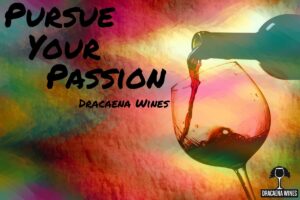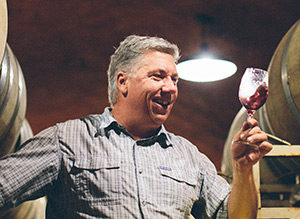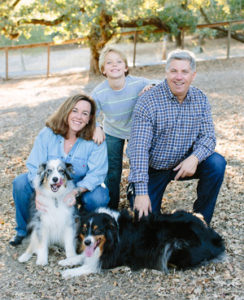 What is the definition of being successful? Is it making more money than you know what to do with? Is it having letters after your name that people aren’t even sure what they mean? Or is it simply being happy? When Mike and I decided to enter the wine business, we knew it wasn’t going to be an easy road. We were realistic. We understood that we would neither be an overnight sensation, nor ever be as recognized as Robert Mondavi. That’s not why we entered the business. We entered the wine industry because we love wine and it was our dream to own a winery. We chose to not just wish or dream about it, we made a conscious decision to make it happen. We chose to Pursue Our Passion.
What is the definition of being successful? Is it making more money than you know what to do with? Is it having letters after your name that people aren’t even sure what they mean? Or is it simply being happy? When Mike and I decided to enter the wine business, we knew it wasn’t going to be an easy road. We were realistic. We understood that we would neither be an overnight sensation, nor ever be as recognized as Robert Mondavi. That’s not why we entered the business. We entered the wine industry because we love wine and it was our dream to own a winery. We chose to not just wish or dream about it, we made a conscious decision to make it happen. We chose to Pursue Our Passion.
It’s a scary thing chasing down your dreams, but if you don’t enter the race you are never going to win. One of my favorite sayings about Pursuing Your Passion was made by “The Great One,” Wayne Gretzky. He very eloquently stated, “You miss 100% of the shots you don’t take.” He knows you need to take risks. You need to leave the safety net that tethers you to your comfort zone so that you can experience what happens next.
In this, what has become a monthly tradition, a guest blogger will tell you their story of how they pursued their passion in the wine industry. These people understood what Van Gogh meant by “I would rather die of passion than of boredom.”
I am always looking for something new to try. I guess I like learning new things. A few years ago, I had no idea what a blog was, now I write one and read many. About a year ago, I saw someone on social media mention a podcast. Podcast? I asked myself… What the heck is a podcast. Off to Google I went and I found out what it was and subscribed to a few of them.
I now listen to podcasts on the way to and from work. I gave up my Sirius subscription because I was never using it. I now have about ten podcasts that I religiously listen to and others that I scan through and listen to depending on what the topic is. Plus, I now produce my own podcast with the very clever name Dracaena Wines Podcast that can be found on iTunes, Stitcher, Google Play and Spotify just to name a few places.
One of the podcasts I never miss is The Wine Maker’s Podcast. It is a podcast from Sonoma, CA featuring experts Brian Casey, Sam Coturri, Bart Hansen & host John Myers with a tagline of “Taking the stuffiness out of wine every Friday!” Each episode is about an hour-long, and is always filled with interesting information and conversation. Plus I am totally jealous of all the bottles they open!
I reached out to Bart through social media and asked if he would be interested in being a

guest on my Pursue Your Passion blog series and to my happiness, he responded yes! I immediately got to work on the interview questions. There were so many ways I could have gone since his career is so intriguing! Between his winery and the podcast, I don’t know where he found the time for the interview, but I am thrilled he did. Now I just need to get my hands on some of his Chenin Blanc… did you know he made Chenin Blanc? I hope you enjoy his story of Passion.
~Sláinte!
You first job in the wine industry was driving a truck full of grapes down a mountain. How does driving a truck lead to the decision to be a winemaker?
So you have to back up a little more than that for the whole story. I was 20 years old going to Santa Rosa Junior College taking GE classes and managing a Record Store The Music Coop. I grew up in Petaluma and most of my family was in the dairy industry so agriculture was on my radar. It was my mom that said wouldn’t it be fun to work in the wine business. So, one day I went looking for a job. It was mid-July and I stopped at Kenwood Vineyard and happened to meet the owner/winemaker Mike Lee. He interviewed me about a crush job. He explained that it would be a minimum of 12 hours a day with no days off for about 8 weeks, but they fed us a great lunch and it would be the hardest I ever worked but the most fun I had ever had in a job. I accepted the job that day and didn’t really know what to expect.
Your professional career began when you accepted a job with Kenwood Vineyards. Did you start in the vineyard? Cellar rat? What were your first responsibilities?
My first day harvest hadn’t quite started so they had me help pull orders in the warehouse and help out on the bottling line. Shortly thereafter harvest started and I was working with the vineyard crew. We would do all the prep, getting the grape gondolas and tractors ready in the vineyard. I’ll never forget the first day’s pick on top of a vineyard in what is now the Moon Mtn. District appellation. As soon as it was light enough the crew of 40 started, singing, bantering and picking the Chardonnay with lighting quick precision. My job was to help dump the bins in the gondola and pull out any leaves, once the gondola was full I hauled it down to the winery as soon as possible. It was a bit daunting, the gondola held about 5 tons of fruit, to say the grapes pushed my truck down the hill was an understatement. Once I arrived at the winery we weighted the fruit and started crushing the grapes. At that point I was already hooked, just the whole excitement and urgency of getting the grapes to the winery and the team of people all focused on this process was amazing.
You spent thirteen years there. Your title was Cellar Master. What are a Cellar Master’s responsibilities?
Well, it supposed to be a temp job, but in November after all the grapes and been pressed and I had spent several weeks on the business end of a pressure washer cleaning all the equipment they asked me to say on. I wouldn’t be working in the cellar but there was a position in the warehouse and learning about the bottling line. After a few years of learning the ins and outs of the bottling line and becoming an incredible forklift driver I was asked to come help move barrels in the cellar. It was then that I started my “apprenticeship” in making wine. The crew at Kenwood was amazing, they had all worked together for at least 10 year at that point and they taught me everything weather it was racking lot barrels to a tank of cleaning the drains, we did it together. There was a right way to do it and a lot of pride in what we did. I was given the title “Barrelmaster” because eventually I was in charge of all things barrels. We had about 16,000 barrels and our crew of 4 guys kind of worked daily filling and emptying barrels throughout the year.
What would you say are the necessary skills in order to be a successful Cellar Master? Are there any specific classes that you recommend to someone looking to get a job?
Being very well-organized, methodical and ready to change the plan at any point is a great start. I believe that the best class for making wine is making wine, and by that, I mean working in the vineyard or cellar. Spending time understanding and constantly learning what happens in the cellar and how it effects the wine. I have done this for a few years now, and I have seen a lot of harvest interns come and go and my favorite interns are the ones that understand that love working in the cellars.
Working in the cellar is not an easy job, but it is often romanticized. How would you respond to this statement?
Working in the cellar romanticized? Really…
Let’s face it cellars work is kind of glorified plumbing and about 80% cleaning, it’s hard work and a place where attention to detail if the most important thing everyday. Using all your senses, tasting, smelling and observing.
You left Kenwood Vineyards to become part of the winemaking team for Benziger Family Wines. What made you decide to make the change?
Kenwood had sold to Korbel and it was apparent that there were upcoming changes mainly in that they were going to be growing quite a bit. I knew one of the Benzigers and had been talking to them and their Assistant Winemaker was leaving. They were another family owned winery and smaller than Kenwood focusing on small lots and some pretty amazing vineyard to work with. And at the time they had a brewery and everyone knows. “It takes a lot of beer to make great wine”
Your main responsibilities were for the Zinfandel wines for Benziger and Imagery Estate. First tell us the relationship between the two wineries? Secondly, how does their focus on wines differ?
My time with the Benzigers was so multi-faceted and dynamic I wouldn’t call being responsible for the Zinfandels my main focus. When I started the Benzigers had just started down the road to converting to Biodynamic farming and increasing the amount of organic grapes. Mike Benziger was running the Biodynamic program focusing on their Sonoma Mountain Estate so a large amount of my time was spent working with our crew and Mike on his wines. We were developing winemaking protocols for Biodynamic wines and learning how to farm the property. I also worked directly with Mike’s brother Joe on the Imagery Estate wines, this operated with in the winery in Glen Ellen. But Imagery focused on unique varieties from equally unique locations from all over. We got Syrah from Bien Nacido in Santa Maria, Malbec from Lake County and Mourvèdre from Alder Springs in Northern Mendocino County.
After almost 9 years with Benziger, you joined Lasseter Family Vineyards. What are the major differences between making larger batch wines and small lot?
When our son Dane was born in 2007 Teri and I decided that I would take the opportunity to stay home with him. In July I received a phone call from the consulting winemaker saying a local winemaker told her I might be looking interested in some part-time work. That year we did about 9 tons of fruit. We had been doing lots of small lots at Benziger so managing 15 different small lots wasn’t problem. I would bring Dane to work with me in the morning and then take him home for a nap. In the afternoon when Teri was back home I would go back to the winery and work for a few more hours.

At about the same time, you decided to begin your own label Dane Cellars. Tell us the story behind the name. What was behind the final decision to create your own label?
We decided to start Dane Cellars just after I left Benziger, not wanting to just walk away from winemaking I was able to buy a small amount of Zinfandel and Cabernet from Chuy Ordaz, he was the vineyard manager from Kenwood and had started his own company Palo Alto Vineyard Management. I had been making homemade wine for years but never had a label, when Dane was born it just seemed like a fit.
Tell us about your vineyards. Do you own them, or are you sourcing fruit from them? What about them made you decide, “These are the vineyards I want!”
I buy grapes, I have had the chance to get to know and work with some of the best grape growers in Sonoma County over my years at Kenwood and Benziger. I knew that I was going to focus on Sonoma Valley grapes especially since I have worked here my entire career.
You are currently producing 5 wines. How many wines would you ultimately like to produce? Do you plan on sticking to varietals or could there be blends in the future?
I would say that our core wines are Zinfandel and our Rhone Blend Valeria or another Rhone varieties like Grenache or Syrah. I have made a couple different Cabernets in the past but haven’t really found the right vineyard opportunity yet. Trust me we have had some amazing Cabernets but usually it was a last-minute opportunity for a small amount of fruit. I also make Chenin Blanc, I fell in love with Chenin while working at Kenwood, we had some great sources in Clarksburg and even some Sonoma valley Chenin grown at about 1500 feet. The first few years of Chenin were from an old Kenwood source in Clarksburg. My current Chenin Blanc was planted in 1944 from Mendocino County.
Two of your five wines are Zinfandels. Is this your passion wine? Did you love Zinfandel prior to your Benziger days?
Zinfandel was my first passion wine, we all loved Zin at Kenwood. We had amazing old vine vineyards in those days that produced wines with great structure and richness. My first homemade wines were Zin, it’s just always been what I reach for. But no doubt that in the past 12 years that Rhone varieties have become a new passion. But for the longest time there just weren’t that many acres planted in Sonoma Valley and most of the fruit was contracted to wineries.
Wine making is often described as both an art and science. Do you agree with this? What percent would you say is art? What percent is science? Does that percentage change depending on what is happening in the vineyard each year?
I do agree with the art and science description. I guess because most of my training has come from a production background I lean towards a higher percentage of art. But the science reinforces the art. Yes, what’s happening in the vineyard and the growing year changes the percentage yearly, that’s what makes it so exciting and challenging every year.
Tell us about The WineMaker’s Podcast. How did you get involved? Who’s idea was it? Tell us everything!
The podcast has been awesome, it started with our local radio station KSVY. John Meyers (consumer) would have Brian Casey (sommelier) Sam Coturri (grower) and myself (winemaker) on his weekly show. We have recorded 45 episodes and have over 15,000 downloads. We have guest on to learn about their passions concerning wine and talk about what’s going on in the wine business. Whether the latest trend or what going on seasonally in the cellars and the vineyards. And we are always popping bottles of wine, it’s a fun listen. I hope people will give it a listen.
One of our tag lines is “Pursue Your Passion.” You obviously have passion for wine. If you were to give advice to someone entering the wine industry to pursue their passion, what would you tell them?
I would encourage them to make the jump, it’s a huge industry now. There are so many more opportunities now than when I started. But if you think you want to be a winemaker that it starts in the vineyards and the cellar. Learn ever part of grape growing and winemaking that you can, from pruning to bottling. Don’t be in a hurry it’s taken me 32 harvests to realize that I have a lot more to learn and that’s what makes it exciting.
Dracaena Wines now has a Wine Club! We named it the CHALK CLUB. Draco is on our label, but Vegas was getting a little jealous. So we decided he deserved to be club spokesdog. In Las Vegas, betting CHALK means you are betting on all the favorites. We are betting that we are one of your favorite wineries, so we thought the name was apropos. The club is simple yet a bit different from most. When you wager on us, we will ship you three bottles of wine twice a year; once in April and once in September. You can choose all red or a mix of red and rose’. You immediately receive 15% off ALL your wine purchases but what makes our club stand out is a progressive discount. Let your club membership ride into the next year, your discount increases. Each year you parlay your membership, you receive an additional 5% off up to a plan maximum of 25%. Your club shipments are discounted. Flat $15 shipping PLUS we’ll cover your club shipping cost for your second shipment. That is $15 house money in a sure bet for you! So please head to our website; www.dracaenawines.com/chalk-club to find out all of the benefits of joining the CHALK CLUB and to sign up. We’ve stacked the odds so that you can get our award-winning wines without breaking the bank.